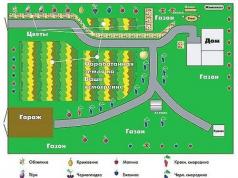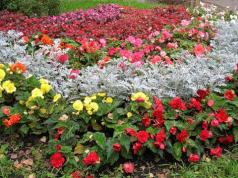It is impossible to imagine the hostess's kitchen without onions. Let his tears flow like a river, but in many dishes a vegetable is necessary. Therefore, in private plots, onions are grown everywhere. It is planted either for the winter or in the spring. Onions grow well. Rarely enough is capricious and dissatisfied. But it signals about serious problems. Often - yellowing of the feather.
What if the onion turns yellow? It all depends on the season. If the onion began to turn yellow in June, for example, then this is bad. The plant is not satisfied with something. Or someone is wound up in the garden. You need to figure out why the feather of the onion turns yellow, and take action. If this happens at the end of July, then there is no cause for concern. The harvest began to ripen. We will clean up soon.
Provocateurs of yellowness
Why do onion leaves turn yellow? Causes of the problem: a pest has wound up, there is not enough nitrogen in the soil, the plant lacks moisture. Rescue measures will depend on the specific reason.
Pests
As a rule, the plant is damaged by flies and lurkers.
Onion fly
Symptoms of its presence: feathers turn yellow and wither early, a larva can be found in the bulb, the vegetable rots, and the plant is pulled out of the ground very easily, even accidentally during weeding.
Pest orientation:
1. The size of an adult is about seven millimeters. The body is yellowish-gray with dark sparse stripes.
2. The larva is a white worm with cone-like processes at the end. It can be seen in the bulb or in the soil near the plant.
Pupae of flies overwinter in the soil. In the spring, the pupae wake up. A clutch of eggs coincides with the flowering of dandelions. After a week, the larvae appear. They make their way into the bulb and feed on it.
Protective measures:
- deep digging of soil before sowing;
- early landing;
- proximity to carrots, the smell of which scares off flies;
- destruction of infected plants;
- sprinkling the earth around the onion with ash mixed with tobacco dust;
- cleaning from the garden of all plant residues.
Onion lurker
A very dangerous pest that eats away feathers from the inside. Signs of its invasion: on the leaves - white specks and longitudinal stripes, yellow tips of feathers, curling and drying of the feather. For young plantings, both adults and larvae are dangerous.
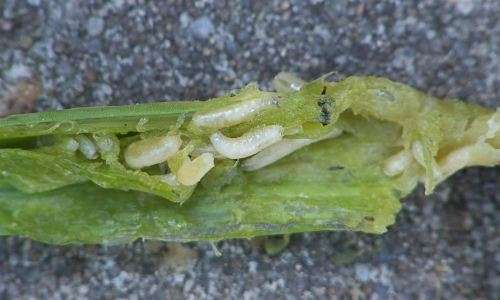
How to recognize a pest?
1. An adult beetle is a small insect up to two millimeters long. The body is covered with light scales. The tarsi and elytra are brownish. There is a light stripe at the base of the elytra.
2. The larva is a light-colored worm with a dark head.
Lurkers hibernate in the ground, grass, bushes, or unharvested onions. They feed on them in the spring, gradually moving to fresh plantings. The female gnaws an onion feather and lays eggs there. After two weeks, the larvae are born. They eat the inner contents of feathers, and then descend into the soil to pupate.
Protective measures:
- timely cleaning of plant residues;
- sowing on ridges remote from the plantings of the previous year;
- regular loosening of row spacings;
- cutting off damaged feathers plus loosening.
Lack of nitrogen in the soil
It can be observed both on dry days and on rainy days. Nitrogen is absorbed in dissolved form, so moisture is needed. At the same time, after heavy rainfall, nitrogenous compounds go too deep, from where the plant roots cannot absorb them.
To compensate for the nitrogen deficiency, periodically onions are fertilized with nitrate, ammonium sulfate, urea or slurry.
Lack of moisture
During the period of active growth and gaining strength, the onion needs regular watering.
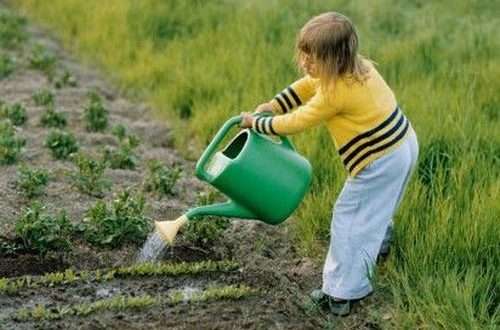
- the plant is watered before and after weeding;
- water is poured into the grooves made between green bushes;
- with dense plantings, when you have to water over the feathers, use a watering can so that the water does not wash out the soil near the bulb;
- the need for watering is checked with a finger; if the soil is dry at the depth of the nail, then you need to water it;
- watering is stopped a month and a half before harvesting.
Pen salvation
Consider several popular methods of comprehensively dealing with the problem. That is, such recipes that allow you to immediately eliminate several reasons.
1. In ten liters of warm water, dissolve half a glass of table salt and one ampoule of ammonia. Add three cakes of ash. Water this composition every ten days. Until the feathers turn green again.
2. Soak the planting material in strong potassium permanganate and plant in rows sprinkled with salt.
3. For half a bucket of water - half a tablespoon of iodine, two bags of potassium permanganate and five hundred grams of soda. It is a concentrated formulation. It must still be diluted in water at a ratio of 1:10. And already divorced to water.
4. Sprinkle the aisles with sand mixed with mothballs.
5. Pour salt water with potassium permanganate on the onion.
That's all the subtleties. And finally - a photo of interesting ideas for serving onions to the table.
Original Feather Salad Bowl:
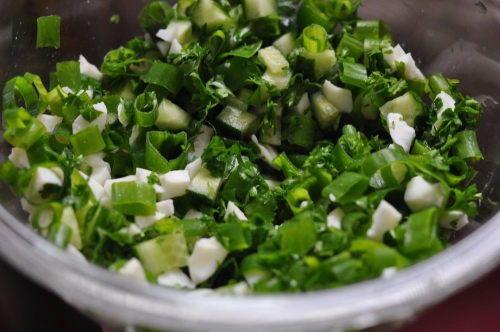
A straw was used as a support. The bottom of the basket is a slice of black bread. Salad ingredients should be paired with onions to taste.
Onion palms:
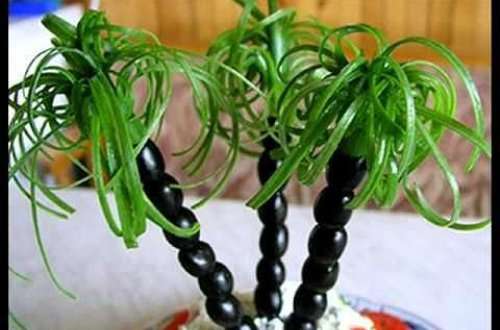
Barrel - kebab skewers with skewered olives. The foliage is green onion feathers.
And this is just an onion beauty:
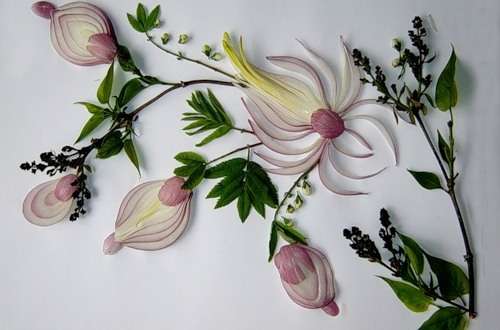
Have a beautiful harvest!

